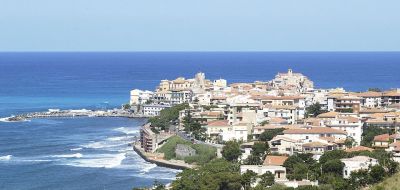L'articolo parla del villaggio storico di Diamante, situato sulla costa tirrenica calabrese. Nel 1981, Nino Razetti, un pittore milanese, ebbe l'idea di utilizzare l'arte per attrarre più turisti a Diamante. Con il sostegno del sindaco, Evasio Pascale, Razetti invitò 80 pittori a Diamante con l'obiettivo di dipingere una serie di murales sulle pareti degli edifici. Dopo più di 40 anni, i murales sono diventati parte integrante della cultura storica di Diamante. Uno dei murales più iconici raffigura un gruppo di contadini che raccolgono i cedri. I cedri di Diamante sono considerati una delle varietà più antiche d'Italia. La buccia di questo cedro viene utilizzata nella famosa bevanda Cedrata Tassoni. Nel 1992, il giornalista Enzo Monaco istituì una sagra dedicata al peperoncino Diavolicchio, una delle varietà più piccanti di tutta la Calabria. La sagra ebbe così tanto successo che ora si tiene ogni anno a settembre.
On the west coast of Calabria, along the Tyrrhenian Sea, the historic village of Diamante provides the backdrop for an open-air museum of several hundred murals painted on the buildings that line the narrow streets. The artwork varies from religious to secular, traditional to contemporary to abstract, showcasing a worldwide assemblage of artists.
In 1981, Nani Razetti, a painter from Milan who often visited Diamante, approached the mayor of the town, Evasio Pascale, with the idea that adding art to the buildings would revive the seaside village. Labeled “Operation Murales,” Razetti invited more than 80 artists to participate in the project. Many of the original works are still on view, with some that have been restored after years of facing the environmental elements of sun, wind and sea spray. In addition to the paintings, a mosaic depicting the history of Calabria embellishes an exterior wall of the church.
Over the years, other artists have visited the town and painted murals, and in 2021 a 40-year anniversary celebration was held, adding to the collection of artisan themes and styles. Today, estimates of the number of wall paintings range between 200 to over 300. Many of the murals depict fishing scenes – a common sight of everyday life in Diamante – others are portraits with characters that appear to spring to life. From muted tones to brilliant colors, the murals present a kaleidoscope of images, rapidly changing from building to building or with each turn of a street corner.
Included among the images are illustrations of workers harvesting citron – a citrus fruit that looks like a large, wrinkled lemon – used for its thick rind, instead of the juice. The Diamante citron is said to be one of the oldest varieties of citron and chosen by a group of rabbis each year who visit Diamante to select the fruit for the week-long Jewish harvest festival of Sukkot. Held shortly after Yom Kippur, citron (etrog in Hebrew) is used with three other plants to represent the Four Species during the traditional daily Sukkot ceremony. Although citrons from several other countries are also used, legend notes that the Diamante citron was selected during biblical times and the cultivating methods still used today secure that the fruit is kosher.
The ideal growing conditions for citron have established the Calabrian coastline from Praia a Mare heading south about 60 miles to Amantea as Riviera dei Cedri, the Citron Coast, Coast of the Citron or Cedar Coast. (Cedro is Italian for the singular citron and is also used interchangeably as cedar.) The most common method of preparing citron is candied; the thick rind is cooked in a water and sugar solution until softened. Candied citron is most often used in Italian desserts: cannoli, cassata, panettone, panforte, pastiera Napoletana and sfogliatelle are widely known. It’s also used in salads and preserves, added to risotto and other savory dishes, and served fresh, sliced thin and drizzled with olive oil.
The peel of the Diamante citron is used to make Cedrata Tassoni soda, a non-alcoholic sparkling soft drink launched in 1956 from a different variety of citron. First made from a syrup developed in the early 1920s, the addition of water and carbon dioxide transformed the syrup into a popular thirst quencher. Likewise, the citron peel is used to make cedrello, a liqueur similar to limoncello, but with a milder flavor. Citron is also used in cosmetics, perfume and health products.
About 10 miles northeast of Diamante, the Cedar Museum – located in the Palazzo Gabriele Marino in Santa Maria del Cedro – showcases the fruit’s production and features the history of the citron through interactive displays.
The Southern Apennines stretch through the entire region of Calabria and closely hug the shoreline of Riviera dei Cedri, with its steep cliffs dropping into the Tyrrhenian Sea. The sea and the mountains create a climate of fairly moderate temperatures and ample moisture. The type of soil and long, sunny days provide the perfect conditions for growing peppers. Calabrian peppers are prized for their flavor, often described as complex – a zesty combination of heat, fruit, and smoke.
In 1992, journalist and food enthusiast Enzo Monaco organized a festival in Diamante for the chili pepper, an event planned to highlight the connection between Italy and the Americas. Focusing on the 500th anniversary of Columbus returning to Europe with chili peppers from the New World, Monaco sought to highlight both the pepper’s versatility and the regional foods of Calabria. The Diavolicchio is the hottest pepper cultivated in the region, and it was renamed Diavolicchio Diamante.
The festival was so successful, two years later Monaco founded the Italian Academy of Chilli Pepper, a non-profit organization that sponsors the Peperoncino Festival – a multi-day cultural event – held each September in Diamante. Numerous food establishments offer a wide assortment of dishes, condiments and sauces made with chili peppers. Entertainment, exhibits, demonstrations and tastings add to the festivities; and educational and medical seminars are offered.



